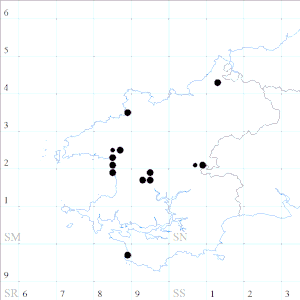Trans-Saharan migrants, Sand Martins usually arrive in Pembrokeshire in March, but were recorded as early as the 14th February during the 2003-07 Atlas survey period.
In Pembrokeshire, Sand Martins nest in sandy/gravelly river banks, in soft sandy/gravelly sea cliffs and in artificially created habitats, notably sand and gravel pits. They are highly colonial, and return to the same colony site, although they generally dig fresh nesting burrows, to avoid parasitic infestation. Sand Martins feed mostly on aerial insects, foraging over freshwater, wetlands and pasture, preferably grazed by cattle. They generally avoid urban and densely /wooded areas.
As illustrated by the map, on the mainland colonies are scattered on the coast and inland. With the exception of a cliff site in the Freshwater West area, all the colony sites were found in mid and north Pembrokeshire. Sand Martins are absent from the offshore islands.
At first glance, a comparison between the two tetrad surveys suggests a significant expansion in the breeding population of Sand Martins. A closer inspection of both the numbers of tetrads where Sand Martins were recorded and the tetrad map, however, revealed a 10% decrease in the number of tetrads where breeding was confirmed. There were also changes in distribution of colonies: They have disappeared from four tetrads in between the two surveys. This was counter-balanced by the recording of several new colonies, mostly on the coast.
The two sets of tetrad data for “confirmed” and “probable” breeding are very similar, although the tetrad map clearly suggests changes in distribution of colony sites. This could well indicate that suitable nesting habitat is a finite resource in Pembrokeshire, hence a potential limiting factor on the distribution and size of future breeding colonies of Sand Martins.
Sand Martin colonies tend to be transient, and will move if a particular sandy bank becomes over-stabilised. On rivers, fresh bank falls that occur whilst rivers are in spate will be preferred to stable bank/cliff faces that may become over-gown. Similarly, artificial sites e. g. sand and gravel pits will also be deserted once exposed faces become too stable, hence unsuitable for Sand Martins, they even move around within active sand pits. This is likely to be a contributing factor in the changes in distribution noted between the two surveys: sites may have fallen into disuse because they no longer offer suitable exposed, soft sandy/gravelly cliffs which birds can burrow into, yet are firm enough for the burrows to remain intact during the breeding season.
The overall size of the breeding population is not thought to have changed significantly between the two tetrad surveys, and is thought to be between 70 and 100 pairs ( the population estimate given in Donovan and Rees (1994) was based on accurate colony counts).
Jane Hodges

Fieldwork 2003-07 (based on 490 tetrads)
Large dots = breeding confirmed = 11
Medium dots = breeding probable = 2
Total tetrads in which registered = 13 (2.7%)
 Friday, August 23, 2013 at 7:56AM
Friday, August 23, 2013 at 7:56AM  1949 BoP in
1949 BoP in  Sand Martin
Sand Martin 




